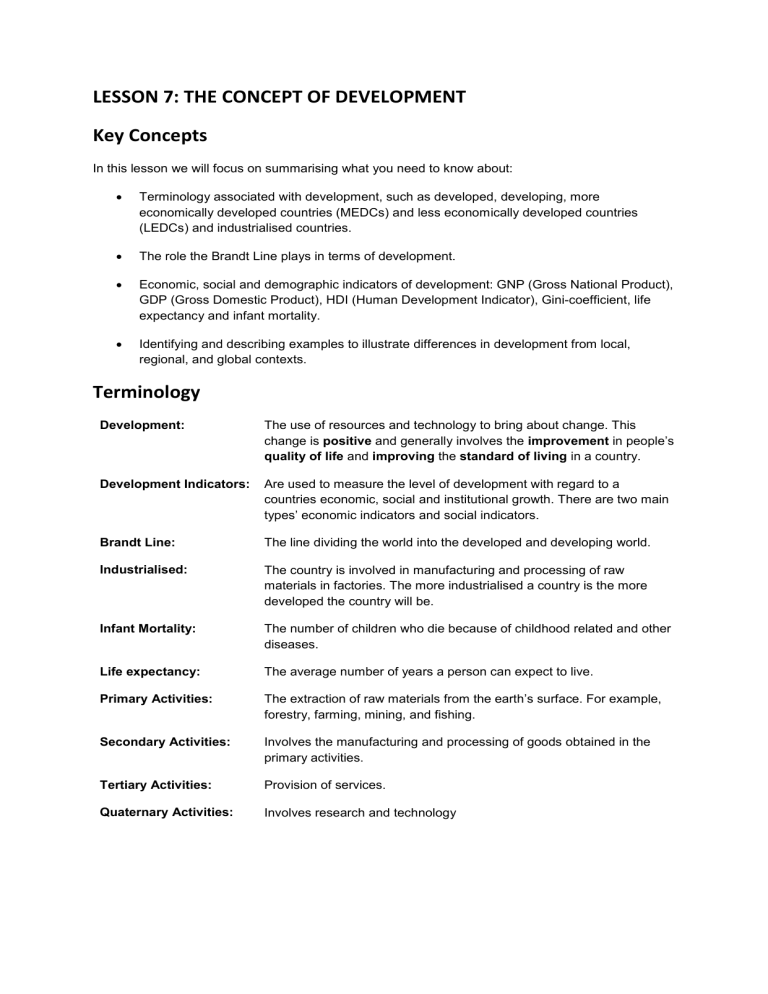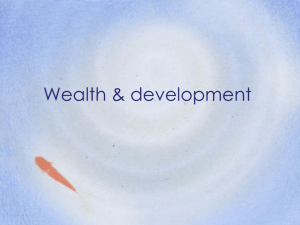
LESSON 7: THE CONCEPT OF DEVELOPMENT Key Concepts In this lesson we will focus on summarising what you need to know about: Terminology associated with development, such as developed, developing, more economically developed countries (MEDCs) and less economically developed countries (LEDCs) and industrialised countries. The role the Brandt Line plays in terms of development. Economic, social and demographic indicators of development: GNP (Gross National Product), GDP (Gross Domestic Product), HDI (Human Development Indicator), Gini-coefficient, life expectancy and infant mortality. Identifying and describing examples to illustrate differences in development from local, regional, and global contexts. Terminology Development: The use of resources and technology to bring about change. This change is positive and generally involves the improvement in people’s quality of life and improving the standard of living in a country. Development Indicators: Are used to measure the level of development with regard to a countries economic, social and institutional growth. There are two main types’ economic indicators and social indicators. Brandt Line: The line dividing the world into the developed and developing world. Industrialised: The country is involved in manufacturing and processing of raw materials in factories. The more industrialised a country is the more developed the country will be. Infant Mortality: The number of children who die because of childhood related and other diseases. Life expectancy: The average number of years a person can expect to live. Primary Activities: The extraction of raw materials from the earth’s surface. For example, forestry, farming, mining, and fishing. Secondary Activities: Involves the manufacturing and processing of goods obtained in the primary activities. Tertiary Activities: Provision of services. Quaternary Activities: Involves research and technology X-planation Geographers classify countries according to their level of economic and human development. There will always be poor people in rich countries and rich people in poor countries. The Brandt Line is used to divide the world into two halves, the developed north (rich, industrialised) and the developing south (poor).The Brandt Line may also be referred to as the North-South divide. It is important to remember that the Brandt line is not the same as the equator. There are some countries that are found in the Southern Hemisphere but are north of the Brandt Line e.g. Australia. Below is a table comparing the main differences between Developed and Developing countries: DEVELOPED COUNTRIES DEVELOPING COUNTRIES First world Third World Rich world Poor World The haves The have not’s More economically developed countries (MEDCs) Less economically developed countries (LEDCs) Industrialised Non-industrialised/ Industrialising The North The South High income Low income High human development index (HDI 0.8+) Low human development index (HDI 0,5 and less) E.g. United States of America, France, Japan E.g. India, Ethiopia, Brazil Indicators of Development Measuring development between different countries is very difficult. That is why geographers make use of different indicators in order to compare the level of development around the world. There are three different types of indicators that can be used in order to compare development: Indicators of Development Economic Indicators Social Indicators Demographic Indicators (Show how well off a country is economically) (Show level of human development, welfare and quality of life) (Statistics of a country’s population) Economic Indicators Gross National Income (GNI) – the amount of money the average person in a country can expect to have. (Low income and middle income countries are developing while high income countries are developed). Gross National Product (GNP) – Total value of all goods and services produced by a country in one year including foreign earnings. Gross Domestic Product (GDP) – Shows the total value of all goods and services produced by a country in one year. NB! All of the above indicators are often given as per capita or per person. To calculate this amount you take the GNI, GNP or GDP and divide by the country’s total population. It is therefore an average amount that is available to each person in that country. Human Development Index (HDI) – This indicator is a combination of GDP per capita, life expectancy and literacy rate. Zero (0) indicates the worst quality of life, while one (1) shows an almost perfect place. Top 10 Countries according to the HDI Bottom 10 Countries according to the HDI (2013) (2013) NORWAY (0,955) BURUNDI (0.355) AUSTRALIA (0, 938) GUINEA (0,355) UNITED STATES OF AMERICA (0,937) CENTRAL AFRICAN REPUBLIC (0,352) NETHERLANDS (0,921) ERITREA (0,351) GERMANY (0, 920) MALI (0,344) NEW ZEALAND (0,9 19) BURKINA FASO (0,343) IRELAND (0,916) CHAD (0,340) SWEDEN (0,9 16) MOZAMBIQUE (0,327) SWITZERLAND (0,9 13) DEMOCRATIC REPUBLIC OF CONGO (0,304) JAPAN (0,912) NIGER (0,304) Gini-coefficient – Indicates how wealth is shared in a country. A Gini score of 0 indicates complete equality in income (every household receives the same amount of money). A Gini score of 1 indicates complete inequality (income received is not the same; one household gets more than the other). Greatest Income inequality Most income equality Namibia (0,74) Denmark (0,24) Sierra Leone (0,62) Japan (0,24) Social Indicators Social Indicators may include things like: The percentage of the population living in urban areas Education levels and level of literacy Availability of services such as water, electricity and healthcare Food and nutrition Demographic Indicators The following are examples of demographic indicators and are usually obtained through a census in a particular country. A Census is an official counting a country’s population which is usually done every ten years. Birth rate Death rate Infant mortality rate Life expectancy Maternal Mortality rate( the number of mothers who dies during childbirth) Population growth rate (the percentage by which a country’s population grows each year) Fertility rate (the expected number of children the average women in a country has) Development from different contexts – local, regional and global Local – refers to development in the area in which you are living. Development in a local context is often small-scale. Regional – refers to development in an area that has similar characteristics which distinguish it from other areas (e.g. Gauteng) Global – refers to development worldwide. Here the best example is the Millennium Development Goals. These goals included: Eradicating extreme poverty and hunger Achieving universal primary education Promoting gender equality and empowering women Reducing child mortality Improving maternal health Combating HIV/AIDS, malaria and other diseases Ensuring environmental sustainability Developing a global partnership for development X-ample Questions Question 1 Complete the following table which summarises the development indicators for developed vs. developing countries. INDICATOR DEVELOPED COUNTRIES (MEDCs) DEVELOPING COUNTRIES (LEDCs) GNP/capita (also GDP and GNI) Human Development Index Gini coefficient Birth rate Death rate Infant mortality rate Life expectancy Adult literacy Urbanisation rate Population structure % working in primary activities % working in tertiary and quaternary activities Daily calorie intake Question 2 Study the development indicators for the countries shown in the table below and answer the questions that follow: Infant mortality rate (IMR) per 1000 live births Country GNP (US $) GNI/capita (US $) HDI Gini coefficient Life Expectancy (years) Mozambique 20,2 bill 900 0.28 0.40 41 104 Norway 267,4 bill 57 400 0.94 0.26 80 3.6 Vietnam 256,9 bill 2900 0.57 0.37 72 21.6 For each question, choose the correct answer from the options given. 2.1 2.2 2.3 2.4 2.5 Mozambique is a developing country because it has a... A: high GNI/capita B: high HDI C: low GNI/capita D: low IMR Norway is a highly developed country because it has a... A: low GNI/capita B: high HDI C: low LE D: large Gini coefficient Vietnam has a reasonably high LE because... A: its GNI/capita is high B: its HDI is reasonable at 0, 57 C: its healthcare sector is weak D: it is a highly developed country The degree of inequality in Mozambique is relatively high because... A: the Gini coefficient is high B: the Gini coefficient is low C: the HDI is high D: the country is north of the North-South divide If the three countries in the table were ranked in terms of their development from most developed to least developed, the correct order would be... A: Vietnam, Mozambique, Norway B: Mozambique, Norway, Vietnam C: Norway, Mozambique, Vietnam D: Norway, Vietnam, Mozambique 0,35 12,4 6,8 82 4,7 99 29,9 Brazil 2 trn 10 100 0,70 0,55 18,1 6,4 72 21,9 90 17,2 Japan 4,2trn 32 700 0,88 0,24 7,4 9,8 82 2,8 99 20,6 Kenya 62,6 bn 1 600 0,47 0,48 35,1 9,3 59 53,5 87 1,4 South Africa 505,3 bn 10 300 0,60 0,57 19,6 17 49 43,8 89 7,7 Switzerland 314,7 bn 41 400 0,87 0,33 9,6 8,7 81 4,1 99 40,7 Thailand 540,1 bn 8 200 0,65 0,42 13 6,5 75 16,7 94 3 USA 14,1 trn 46 000 0,90 0,40 13,8 8,4 78 6,1 99 26,7 Doctors/ 10000 people DR 0,94 Literacy BR 40 000 IMR Gini 851 bn LE HDI Australia GDP(US $) GDP/capi ta (US $) Question 3 3.1 From the development indicators given above in the table list one example of an economic, social and demographic indicator. 3.2 Switzerland has a much lower GDP than Thailand, but a far higher GDP/capita. Explain why. 3.3 Name the three development indicators that are used to calculate HDI. 3.4 Explain why Kenya has got such a low HDI even though its literacy levels are close to South Africa’s. 3.5 Explain why birth rates, death rates tend to decrease with increased wealth in a country. 3.6 From the table above write down the name of the country that best suits the description below: a) Largest GDP b) Lowest GDP/capita c) Highest HDI d) Lowest Gini coefficient e) Lowest Life Expectancy f) Highest Infant Mortality Rate g) Lowest Literacy Rate h) Highest doctor: patient ratio 3.7 According to the HDI figures for Australia, Japan and Switzerland where would one expect to find these countries in relation to the Brandt Line? 3.8 Why do we use US Dollars to give the GDP and GDP/capita statistics? 3.9 Many developing countries such as Kenya have a rapid population growth. How does this affect sustainable development in the country? 3.10 Using information from the table, which country would be the most developed and which country would be the least developed? X-ercise Questions Question 1 (Adapted from Gr 11 Exemplar, DBE, Paper 1, Question 4.5) Refer to the cartoon in FIGURE 1 showing globalisation. FIGURE 1: GLOBALISATION 1.1 Define the term globalisation. (1 x 2) (2) 1.2 What message does the cartoon portray about globalisation? (1 x 2) (2) 1.3 According to the cartoon, which country plays a major role in globalisation? (1 x 2) (2) 1.4 Give THREE reasons why many people are opposing globalisation. (3 x 2) (6) 1.5 In a short paragraph, give suggestions how globalisation can be more beneficial to developed countries. (6 x 2) (12) Solutions to X-ercise Questions Question 1 (Adapted from Gr 11 Exemplar, DBE, Paper 1, Question 4.5) 1.1 Refers to social and economic interconnection between countries 1.2 Creates a negative impression Globalisation is not good Globalisation monopolised by the USA 1.3 The United States of America 1.4 LDCs are exposed to external economic forces over which they have little control Reduced national independence making macro-economic management by domestic governments difficult A state's ability to raise corporation taxation is declining Trans-national companies may relocate if taxed too highly and use transfer price to avoid paying domestic taxes Globalisation may be strengthening the position of the developed economies that are better able to take advantage of free trade Exploitation of resources in LEDCs Labour exploitation in LEDCs e.g. long hours/low wages/child labour, etc. Pollution/Environmental problems in LEDCs Low profits for LEDCs as finished goods are sent back to country where multinational company is situated for export 1.5 Developing economies may gain through foreign direct investment Developing economies may gain through the benefits of trade Developing economies may gain through technology transfer Globalisation can increase the ratio of trade to GDP for many LEDCs Increase in capital flows between counties An increase in trade in goods and services Job creation on LEDCs Improved standards of living in LEDCs

